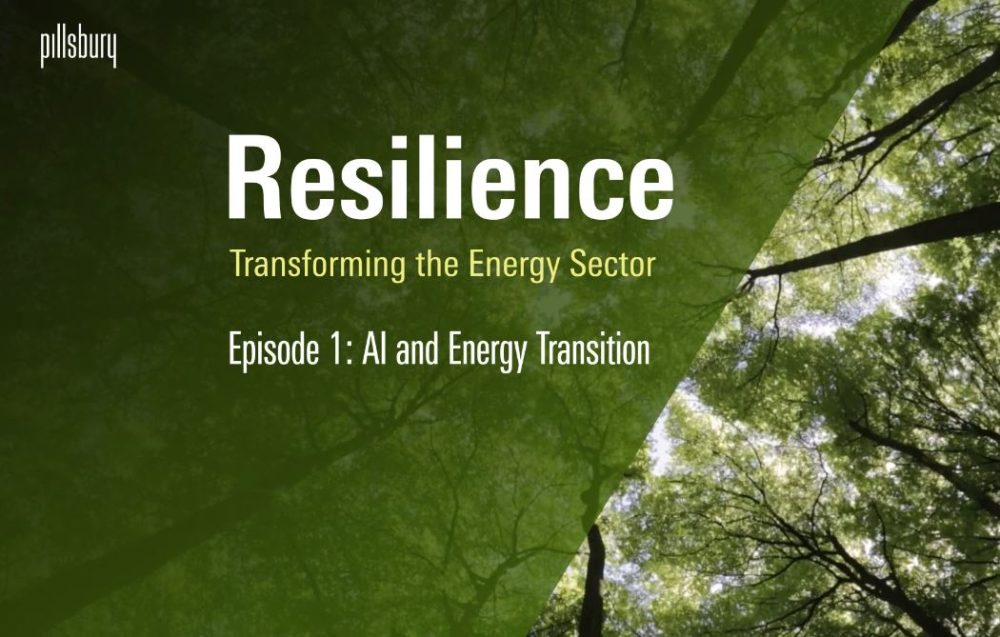Resilience: Transforming Energy Sector – AI & the Energy Transition
Colleague and host Shellka Arora-Cox recently sat down with Sandhya Ganapathy, CEO of EDP Renewables North America, to discuss the fascinating intersection of the energy transition and artificial intelligence.
(Editor’s note: The following transcript has been edited for clarity. From the heart of India resilience has shaped me. Today, I share insights from leaders and innovative thinkers who are motivated by the same strength. Welcome to Resilience where we explore resilience’s role in driving transformation within the energy sector.
I’m Shellka Arora Cox, a partner with Pillsbury Winthrop, Shaw Pitman. Sandhya Ganapathy is the CEO of EDP Renewables North America. She will be joining me today. Sandhya, welcome. Sandhya, welcome.
Sandhya Ganapathy:
Thank you so much, and I’m absolutely looking forward to the conversation.Arora-Cox:
Before we dive into the details of energy transition and AI, could you talk a little about how you found yourself at the helm of EDP Renewables?Ganapathy:
Sure. My journey in renewables began about 13 years ago, when I joined EDP. Before that, I worked as an investment banker. I loved banking but was at a stage in my career when I wanted to do something more purposeful. My family and I had just moved to Houston at the time, and renewables were still a young sector. I started out by leading M&A in North America, and then the group as a entire. Over the last three years, I’ve been running North America, and looking back, I wouldn’t have had it any other way.Arora-Cox:
That’s a great journey. Could you give our listeners an overview of the scope and scale of EDP Renewables’ projects and your day-to-day work?
Ganapathy: Certainly. EDP Renewables, an integrated independent power producers (IPP), is based in Portugal. We are present in 30 countries and the U.S., where we have installed nearly 20 gigawatts across different forms of energy, is our largest market. Our company has a strong focus on renewables. We aim to be coal-free in 2025, completely green by 2030 and net-zero in 2040. About 13,000 people work for us globally. We have been operating in North America for 17 years. Our focus is on onshore and offshore wind, solar, battery, and hydrogen. We have over 10 gigawatts of operating assets and a team of 1,100 people on the ground.
Arora-Cox: You touched on decarbonization goals. Do you see AI as the key to delivering the energy we need, or is it just another tool in our toolkit?
Ganapathy: I wouldn’t categorize AI as just another tool. I would call AI and energy a power pair. The real challenge is ensuring this partnership works effectively.
Traditionally, energy was more straightforward: you had generation, and it was distributed to consumers. The energy landscape has become much more complex. The grid must be able to function seamlessly in this multidimensional environment, where producers are also consumers. AI is crucial to managing this complexity.On the demand side, we’re seeing significant increases in energy consumption, driven by factors such as electrification, manufacturing, and the data needs of AI itself. Energy efficiency has historically helped offset this growth. However, we now find ourselves in a phase of increased consumption. AI is essential for managing demand and ensuring that the increased consumption is in line with decarbonization targets. It allows us to be more efficient by improving areas like predictive maintenance and diagnosis for our wind farms. AI helps us optimize performance by accurately forecasting weather patterns, which is crucial given the increasing unpredictable nature of climate change. Additionally, AI helps balance the grid, especially when integrating renewable sources like solar, wind, and battery storage, ensuring fluctuations are managed more smoothly.
In short, AI is far more than just a tool; it plays a pivotal role in both managing the complexity of energy systems and driving the transition to cleaner, more resilient energy infrastructure.
Arora-Cox:
You mentioned AI’s potential to help meet demand. What percentage of this demand do you think renewables will meet? What role do you think AI will play in decarbonization?
Ganapathy:
AI will play a central role in decarbonization, but it’s not the only factor. I view AI as a key enabler in helping us meet our decarbonization goals, but the success of these efforts will depend on how effectively we integrate AI with other strategies and technologies.For example, on the demand side, we are seeing a surge in energy consumption, driven in large part by digital technologies like AI itself, data mining, and even activities like Bitcoin mining. In the past, energy efficiency improvements have been able to offset rising demand. However, we are now entering a new era in which consumption is increasing at a faster rate, especially as industries shift towards electrification. This increased demand, if left unchecked, could lead to higher emissions–unless we deploy renewable energy at a scale that keeps pace with this consumption.
This is where AI plays a pivotal role. AI allows us optimize the way we generate, store, and distribute energy, especially from renewable sources. AI, for example, can help us manage renewable intermittent resources like wind and sun by improving weather forecasting, and optimizing energy storage. This makes the grid more resilient and ensures that clean energy is available when and where it’s needed.Additionally, AI helps companies like EDP operate more efficiently. AI can ensure that renewable assets such as wind farms and solar panels are performing at their best through predictive maintenance, diagnosis, and real-time tracking. This not only helps reduce downtime but also extends the lifespan of these assets, contributing to more sustainable energy production.
However, AI alone cannot solve all the challenges of decarbonization. The pace of deployment is crucial. There is a significant gap in the deployment of renewables and the increasing demand for electricity. This is driven by AI. Closing this gap will require strong public-private partnerships, streamlined permitting processes, and coordinated efforts across federal agencies, utilities, and developers.
So, while AI is a powerful tool in our decarbonization toolkit, its success will depend on broader structural changes in how we plan, deploy, and manage energy infrastructure. The real challenge is ensuring that the pace of renewable energy deployment matches the increasing demand, and AI will be instrumental in making that happen.
Arora-Cox:
You touched on many stakeholders in the sector, and it’s clear that it’s not just about EDP or any single developer. The U.S. electric grid is one the most complex machines in the world, with thousands generators connected over 600,000 miles transmission lines – twice the distance to the Moon. How do you see AI and your partners in the sector playing a role in enhancing grid resilience?
Ganapathy:
That’s a great question, Shellka, and it truly emphasizes the complexity of the grid we’re dealing with. The U.S. Grid is a complex, massive machine that wasn’t built for the energy landscape of today. The upgrades we have made over the years seem minimal, especially when compared to how rapidly we are changing the way we generate and use energy. The U.S. grid, on the other hand, is much more complex, with thousands and thousands of interconnections, as well as different types of energy sources. AI is absolutely essential in managing this complexity.Today, we have about 1.2 million gigawatts in the system across all forms of energy, including renewables. What’s more, there are over 1.2 million megawatts in the queue to be studied and potentially deployed. AI helps us improve grid reliability by improving forecasting. We can predict conditions more accurately down to the minute. This is important, especially with the increasing unpredictability in weather patterns due climate change. AI helps us integrate distributed resources like microgrids, and optimize the way we distribute power on the grid. Technology alone will not solve all problems. We need structural changes, particularly in the area of long-term planning. FERC’s discussions on long-term planning are encouraging, as they require ISOs and RTOs to think about the next 10, 15 years, which is crucial for the future of energy resilience.
This isn’t about politics or ideology. It’s not about politics or ideology. It’s what’s needed for the country to become energy-resilient and secure, as well as for the economy to flourish. AI will be a critical tool in making sure our grid can meet the demands of tomorrow while supporting our decarbonization goals.Arora-Cox:
As a leader in this space, how are you preparing your teams for this ever-evolving energy landscape?
Ganapathy:
One of my core leadership principles is always being prepared for the unexpected. Michael Phelps’s goggles falling off during a race at the 2008 Beijing Olympics is a great example. He still won the gold medal despite the unexpected challenge. This example speaks to the importance of planning for every possible scenario, even those you wouldn’t anticipate.
In our industry, we have to plan for the unexpected. I tell my team all the time that having a Plan A is not enough. We need to have Plans B, C and even D. It’s important to be prepared for all scenarios in order to ensure the success of a project. We must continually train and upskill the workforce to meet the changing demands of the energy industry. We will all pass the baton on to the next generation at some point. It’s important that they are ready to take this industry to new heights. We’re always looking for ways to improve our efficiency and innovate, whether it’s optimizing assets or improving project planning. That culture of innovation is essential to our long-term success, and we need to foster it at every level of the organization.
Arora-Cox: Looking into your crystal ball, what trends do you see shaping the energy sector over the next two to three years?
Ganapathy: The most significant trend I foresee is the continued rise in energy demand. We must ensure that areas driving demand are also seeing corresponding renewable energy deployment. It is important to deliver projects on time, as both industries and consumers are relying on renewables for their energy needs. Storage is already a major player in the energy sector, but I expect it to grow significantly. By the end this year, I expect to see solar capacity of close to 40 gigawatts and storage of more than 10 gigawatts deployed in the U.S. Storage will be optimized, especially in moving from the current four-hour standard to longer-duration storage solutions. This evolution will enhance grid resilience and reliability.
Additionally, hydrogen is an emerging trend that holds long-term potential. The hydrogen sector is still a long way from where it was 10 or 15 year ago. I am optimistic that we will see significant advancements, though it will take time before hydrogen becomes commercially viable at scale.
Ultimately, I am encouraged by the genuine belief across the sector that renewable energy will continue to take center stage. Renewables are no longer marginalized in the energy mix. They now account for around 20%. We must maintain this momentum in order to achieve greater penetration over the next few years. The energy sector is poised for continued growth, and I am confident that we have the tools and innovation necessary to meet the increasing demands of the future.
Arora-Cox:
Before we close, what keeps you resilient? What makes your work both impactful and enjoyable?Ganapathy:
I genuinely love my job, my company, and the people I work with. Working in the renewable energy industry brings a sense of purpose. We are not just delivering green electricity to the grid, we are also making a lasting contribution to communities. I remember a farmer from Indiana telling me that leasing his land to one of our projects allowed him to send his children off to college. This is a powerful reminder of our broader impact on society. The work we do today will set the foundation for a more sustainable and equitable world, and that’s what keeps me going.Arora-Cox:
As we wrap up, let’s end on a lighter note. Any words of wisdom or perhaps a quote from Ruskin Bond for our listeners?
Ganapathy:
I grew up in India, and like many, I was deeply influenced by British authors who lived there, including Ruskin Bond. One of his quotations that has always resonated for me is “I dream of an expansive, flourishing and fragrant garden.” This quote is particularly meaningful to me because it speaks of the resilience that’s required in our industry. It’s important to keep our dream and purpose in mind, even when things don’t work out. My advice to anyone considering or entering the sector is to focus on the bigger purpose. The journey may not always be smooth, but the dream of building a better, more sustainable future will take you far.
Arora-Cox: Sandhya, thank you so much. May the garden continue to grow greener. Today’s the last day. Next time, we’ll be back with more Resilience.





